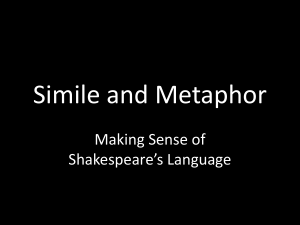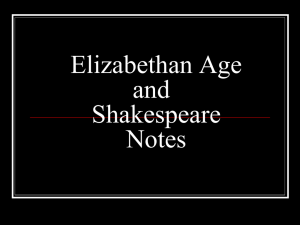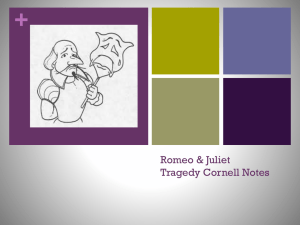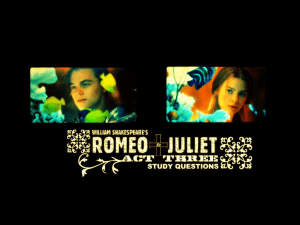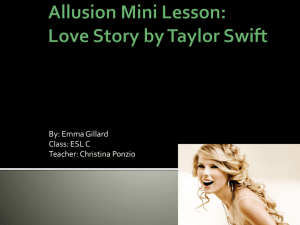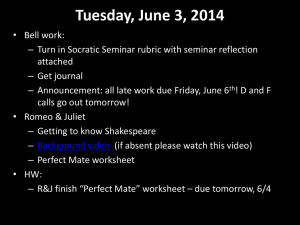Romeo and Juliet - Effingham County Schools
advertisement
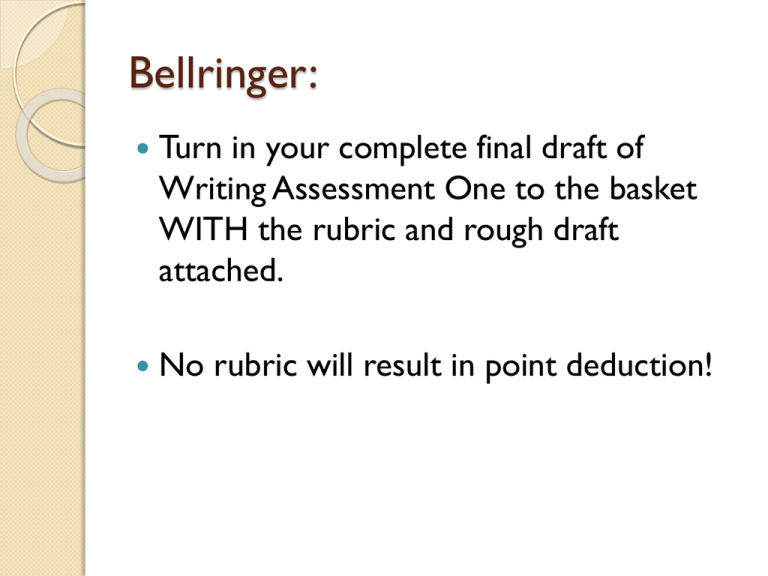
Bellringer: Turn in your complete final draft of Writing Assessment One to the basket WITH the rubric and rough draft attached. No rubric will result in point deduction! Romeo and Juliet William Shakespeare Essential Question How have Shakespeare’s writings helped to develop the English Language? William Shakespeare Widely regarded as the greatest writer in English Literature Actor for Lord Chamberlain’s Men (London theater co.) Also > principal playwright for them 1599> Lord Ch. Co. built Globe Theater where most of Shakespeare’s play’s were performed. He wrote Comedies, Histories and Tragedies. Shakespeare’s Birthplace Theatre Plays produced for the general public Roofless>open air No artificial lighting Courtyard surrounded by 3 levels of galleries The Globe Spectators Wealthy got benches. “Groundlings”>poorer people stood and watched from the courtyard (“pit”) All but wealthy were uneducated/illiterate Much more interaction than today. Differences No scenery Settings > references in dialogue Elaborate costumes Plenty of props Fast-paced, colorful>2 hours! Actors Only men and boys Young boys whose voices had not changed play women’s roles Would have been considered indecent for a woman to appear on stage Romeo and Juliet is a Tragedy Tragedy- In literature, the concept of tragedy refer to a series of unfortunate events by which one or more of the literary characters in the story undergo several misfortunes, which finally culminate into a disaster of ‘epic proportions’. Tragedy is generally built up in 5 stages: a) happy times b) the introduction of a problem c) the problem worsens to a crisis/ dilemma d) the characters are unable to prevent the problem from taking over e) the problem results in some catastrophic, grave ending, which is the tragedy culminated. Review of Literary Devices Simile Metaphor Imagery Personification Diction Tone/Mood Juxtaposition Theme Symbolism Allusion Characterization Characterization is the process by which the writer reveals the personality of a character. Characterization is revealed through direct characterization and indirect characterization. Direct Characterization Direct Characterization tells the audience what the personality of the character is. Example: “The patient boy and quiet girl were both well mannered and did not disobey their mother.” Explanation: The author is directly telling the audience the personality of these two children. The boy is “patient” and the girl is “quiet.” Indirect Characterization Indirect Characterization shows things that reveal the personality of a character. There are five different methods of indirect characterization: Speech Thoughts Effect on others Actions Looks Use the mnemonic device STEAL to remember the five types of indirect characterization. Types of Characters Round Characters: have many personality traits, like real people Flat Characters: One-dimensional, embodying only a single trait ◦ Shakespeare often uses them to provide comic relief even in a tragedy Static Characters: remain the same. They do not change. They do not change their minds, opinions or character Dynamic Characters: change somehow during the course of the plot. They generally change for the better. New Literary Terms Extended Metaphor: a metaphor introduced and then further developed throughout all or part of a literary work, especially a poem. (Ex: The Road Not Taken). Foreshadowing: Suggesting, hinting, indicating, or showing what will occur later in a narrative. Foreshadowing often provides hints about what will happen next. (Ex: Tiresias’ prophecy to Odysseus). Irony: Three Types Situational Irony: accidental events occur that seem oddly appropriate, such as the poetic justice of a pickpocket getting his own pocket picked. Something occurs that the audience does not expect. Dramatic Irony: Dramatic irony (the most important type for literature) involves a situation in a narrative in which the reader knows something about present or future circumstances that the character does not know. Verbal irony occurs when the speaker means something totally different than what he/she is saying. Pun A play on two words similar in sound but different in meaning. (Ex: The church choir robes were too long and needed to be hymned.) One of the cleverest and most morbid puns in Romeo and Juliet comes as a joke from a fatallystabbed Mercutio, who stops joking to explain that “tomorrow … you shall find me a grave man.” Grave means serious, but here it also alludes to his imminent death. Double-entendre A figure of speech in which a word or phrase can be understood in two ways, especially when one meaning is risqué. Basically, a pun with a hidden sexual meaning. Juxtaposition a literary device wherein the author places a person, concept, place, idea or theme parallel to another. The purpose of juxtaposing two directly/indirectly related entities close together in literature is to highlight the contrast between the two and compare them. This literary device is usually used for etching out a character in detail, creating suspense or lending a rhetorical effect. Paradox paradox in literature refers to the use of concepts/ ideas that are contradictory to one another, yet, when placed together they hold significant value on several levels. The uniqueness of paradoxes lies in the fact that a deeper level of meaning and significance is not revealed at first glace, but when it does crystallize, it provides astonishing insight. Oxymoron Oxymoron- pairs of contradictory words. Ex: Jumbo Shrimp Foil A character who contrasts and parallels the main character in a play or story. Ex: Mercutio is a foil for Romeo; Benvolio and Tybalt are also foils. Dramatic Terms Soliloquy: A monologue spoken by an actor at a point in the play when the character believes himself to be alone. The technique frequently reveals a character's innermost thoughts, including his feelings, state of mind, motives or intentions. The soliloquy often provides necessary but otherwise inaccessible information to the audience. The dramatic convention is that whatever a character says in a soliloquy to the audience must be true, or at least true in the eyes of the character speaking. Dramatic Monologue: A poem in which a poetic speaker addresses either the reader or an internal listener at length. It is similar to the soliloquy in theater, in that both a dramatic monologue and a soliloquy often involve the revelation of the innermost thoughts and feelings of the speaker. Aside: In drama, a few words or a short passage spoken by one character to the audience while the other actors on stage pretend their characters cannot hear the speaker's words. It is a theatrical convention that the aside is not audible to other characters on stage. Chorus: A group of singers who stand alongside or off stage from the principal performers in a dramatic or musical performance. Motif Definition: Any element, subject, idea or concept that is constantly present through the entire body of literature. Using a motif refers to the repetition of a specific theme dominating the literary work. Motifs are very noticeable and play a significant role in defining the nature of the story, the course of events and the very fabric of the literary piece. Motifs in Romeo and Juliet A motif is a recurring element, such as a type of incident, a device, a reference, or verbal formula, which appears frequently in works of literature (Ex: hospitality in The Odyssey) Paradoxical nature of life Ship/Bark Banking Earthly Celestial Destiny Education Light Darkness Themes in Romeo and Juliet Life is paradoxical. Destiny and free-will determine our fate. Rules are meant to be broken. Good women become wives and mothers. Love causes violence. Love transcends all limitations. “Thanks Will!” Read the short informational article “Thanks, Will!” Complete a one page objective summary of the text for Homework! Due Friday! Homework: Due Friday! Read the short informational text, “Thanks Will!” and provide a one page objective summary of the text. This is your second homework grade for this 9 weeks! Bellringer Take out your “Thanks Will!” article Open Green text to pg. 771and Have out your Background Notes from yesterday. Also, locate your literary terms for Unit Three. What is a Prologue? a prologue is a section of any introductory material before the first chapter or the main material of a prose work, or any such material before the first stanza of a poetic work. Romeo and Juliet Prologue Follow along while you watch the Prologue of the 1996 version of Romeo and Juliet. Think-Pair Share: Get with partner and paraphrase the prologue. Act 1 Make sure to keep up with notes focusing on literary devices: ◦ ◦ ◦ ◦ ◦ ◦ ◦ ◦ ◦ Foreshadowing Metaphor Paradox Oxymoron Juxtaposition Pun Foil Characterization Imagery Act 1 Examine the opening lines of Tybalt, Benvolio, Juliet, Paris, Lord Capulet, Nurse, and Romeo. What is revealed about the characters? Socratic Seminar expectations Your quiz grades for Pride and Prejudice will be made up by your preparation, participation, and a short ticket-to-leave response based on whole class discussion of the novel. Complete the planning guide provided:30 points Participate effectively in discussion: 50 points Ticket-to-Leave: 20 points. What do I need to bring with me? In class, we will use the edition we have in class, so that when we refer to page numbers, everyone is on the same page (literally!). Complete Planning Guide Homework Questions completed through Volume One (Chapter 23). Writing Assessment Two Focusing on Shakespeare’s theme, the paradoxical nature of life, use Acts 1 and 2 of Romeo and Juliet to explain how Shakespeare conveys the idea through literary and poetic devices. Examine his use of characterization, sound devices, imagery, juxtaposition, and foil, among other terms. Point to specific textual quotes and details throughout your discussion to substantiate your thesis statement. Keep up with the opposites used as we read. In addition to your notes, you have a purple graphic organizer to record evidence of juxtaposition and paradoxes used to further the theme of Life is Paradoxical. Be sure to record quotes. This will make writing your essay MUCH easier.

